 The Babylonians and angle measurement
The Babylonians and angle measurementBut the trigonometrical version is different. If you have the measurements of the two angles and the length of the side between them, then the problem is to compute the remaining angle (which is easy, just subtract the sum of the two angles from two right angles) and the remaining two sides (which is difficult). The modern solution to the last computation is by means of the law of sines. Details are at Dave's Short Trig Course, Oblique Triangles.
All trigonometrical computations require measurement of angles and computation of some trigonometrical function. The modern trigonometrical functions are sine, cosine, tangent, and their reciprocals, but in ancient Greek trigonometry, the chord, a more intuitive function, was used.
Trigonometry, of course, depends on geometry. The law of cosines, for instance, follows from a proposition of synthetic geometry, namely propositions II.12 and II.13 of the Elements. And so, problems in trigonometry have required new developments in synthetic geometry. An example is Ptolemy's theorem which gives rules for the chords of the sum and difference of angles, which correspond to the sum and difference formulas for sines and cosines.
The prime application of trigonometry in past cultures, not just ancient Greek, is to astronomy. Computation of angles in the celestial sphere requires a different kind of geometry and trigonometry than that in the plane. The geometry of the sphere was called "spherics" and formed one part of the quadrivium of study. Various authors, including Euclid, wrote books on spherics. The current name for the subject is "elliptic geometry." Trigonometry apparently arose to solve problems posed in spherics rather than problems posed in plane geometry. Thus, spherical trigonometry is as old as plane trigonometry.
 The Babylonians and angle measurement
The Babylonians and angle measurementThe Babylonians were the first to give coordinates for stars. They used the ecliptic as their base circle in the celestial sphere, that is, the crystal sphere of stars. The sun travels the ecliptic, the planets travel near the ecliptic, the constellations of the zodiac are arranged around the ecliptic, and the north star, Polaris, is 90° from the ecliptic. The celestial sphere rotates around the axis through the north and south poles. The Babylonians measured the longitude in degrees counterclockwise from the vernal point as seen from the north pole, and they measured the latitude in degrees north or south from the ecliptic.
 Hipparchus of Nicaea (ca. 180 - ca. 125 B.C.E.)
Hipparchus of Nicaea (ca. 180 - ca. 125 B.C.E.)Some of Hipparchus' advances in astronomy include the calculation of the mean lunar month, estimates of the sized and distances of the sun and moon, variants on the epicyclic and eccentric models of planetary motion, a catalog of 850 stars (longitude and latitude relative to the ecliptic), and the discovery of the precession of the equinoxes and a measurement of that precession.
According to Theon, Hipparchus wrote a 12-book work on chords in a circle, since lost. That would be the first known work of trigonometry. Since the work no longer exists, most everything about it is speculation. But a few things are known from various mentions of it in other sources including another of his own. It included some lengths of chords corresponding to various arcs of circles, perhaps a table of chords. Besides these few scraps of information, others can be inferred from knowledge that was taken as well-known by his successors.
 Chords as a basis of trigonometry
Chords as a basis of trigonometry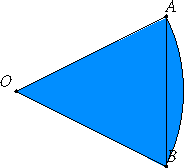 In a modern presentation of trigonometry, the sine and cosine of an angle
a are the y- and x-coordinates of a point on the unit
circle, the point being the intersection of the unit circle and one side of the
angle a; the other side of the angle is the positive x-axis. The
Greek, Indian, Arabic, and early Europeans used a circle of some other
convenient radius. For this description of trigonometry, we'll leave the
radius unspecified as r and it's double, the diameter, we'll denote
d.
In a modern presentation of trigonometry, the sine and cosine of an angle
a are the y- and x-coordinates of a point on the unit
circle, the point being the intersection of the unit circle and one side of the
angle a; the other side of the angle is the positive x-axis. The
Greek, Indian, Arabic, and early Europeans used a circle of some other
convenient radius. For this description of trigonometry, we'll leave the
radius unspecified as r and it's double, the diameter, we'll denote
d.
The chord of an angle AOB where O is the center of a circle and A and B are two points on the circle, is just the straight line AB. Chords are related to the modern sine and cosine by the formulas
|
crd a = d sin (a/2)
sin a = (1/d) crd 2a |
crd (180° - a) = d cos (a/2)
cos a = (1/d) crd (180° - 2a) |
where a is an angle, d the diameter, and crd an abbreviation for chord.
Some properties of chords could not have escaped Hipparchus' notice, especially
in a 12-book work on the subject.
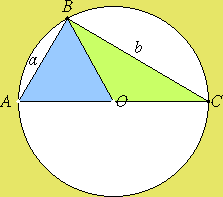 For instance, a supplementary-angle formula would state that if AOB and
BOC are supplementary angles, then Thales' theorem states that triangle
ABC is right, so the Pythagorean theorem says the square on the chord
AB plus the square on the chord BC equals the square on the
diameter AC. Summarized using a modern algebraic notation
For instance, a supplementary-angle formula would state that if AOB and
BOC are supplementary angles, then Thales' theorem states that triangle
ABC is right, so the Pythagorean theorem says the square on the chord
AB plus the square on the chord BC equals the square on the
diameter AC. Summarized using a modern algebraic notation
where d is the diameter of the circle.
Hipparchus probably constructed his table of chords using a half-angle formula and the supplementary angle formula. The half-angle formula in terms of chords is
where r is the radius of the circle and t is an angle. Starting with crd 60° = r, Hippocrates could by means of this half-angle formula find the chords of 30°, 15°, and 7 1/2°. He could complete a table of chords in 7 1/2° steps by using crd 90°, the half-angle formula, and the supplementary angle formula.
What other relations among the chords of various angles that Hippocrates would have known remains speculation.
 Menelaus (ca. 100 C.E.)
Menelaus (ca. 100 C.E.)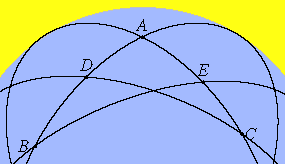
| sin CE sin EA |
= | sin CF sin FD |
sin BD sin BA |
| sin CA sin EA |
= | sin CD sin FD |
sin BF sin BE |
He proved this result by first proving the plane version, then "projecting" back
to the sphere. The plane version says
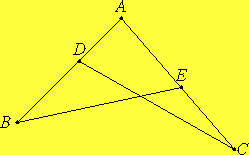
| CE EA |
= | CF FD |
BD BA |
| CA EA |
= | CD FD |
BF BE |
 Ptolemy (ca. 100 - 178 C.E.)
Ptolemy (ca. 100 - 178 C.E.) Ptolemy's Theorem
Ptolemy's Theorem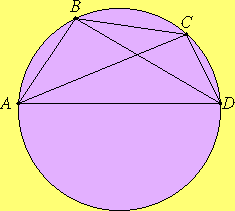 Ptolemy proved the theorem that gives the sum and difference formulas for
chords.
Ptolemy proved the theorem that gives the sum and difference formulas for
chords.
where O is the center of the circle and d the diameter. If we take a to be angle AOB and b to be angle AOC, then we have
which gives the difference formula
| crd (b - a) = | crd b crd (180° - a) - crd a crd
(180° - b) d |
With a different interpretation of a and b, the sum formula results:
| crd (b + a) = | crd b crd (180° - a) + crd a crd
(180° - b) d |
These, of course, correspond to the sum and difference formulas for sines.

Armed with his theorem, Ptolemy could complete his table of chords from 1/2°
to 180° in increments of 1/2°.
 Trigonometry
Trigonometry
The primary source of information in this outline is Thomas Heath's A History of Greek Mathematics, Clarendon Press, Oxford, 1921, currently reprinted by Dover, New York, 1981.